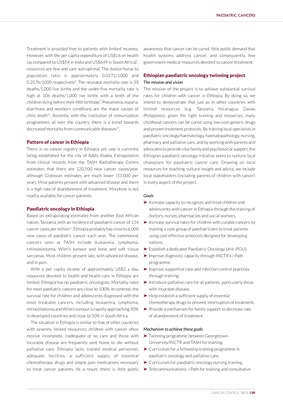
PAEDIATRIC CANCERS
Treatment is provided free to patients with limited incomes. awareness that cancer can be cured, little public demand that
However, with the per capita expenditure of US$16 on health health systems address cancer, and consequently, few
7
(as compared to US$54 in India and US$649 in South Africa) , government medical resources devoted to cancer treatment.
resources are few and care sub-optimal. The doctor/nurse to
population ratio is approximately 0.0272/1000 and Ethiopian paediatric oncology twinning project
0.2576/1000 respectively8. The neonatal mortality rate is 35 The mission and vision
deaths/1,000 live births and the under-five mortality rate is The mission of the project is to achieve substantial survival
high at 106 deaths/1,000 live births with a tenth of the rates for children with cancer in Ethiopia. By doing so, we
9
children dying before their fifth birthday . Pneumonia, malaria, intend to demonstrate that just as in other countries with
diarrhoea and newborn conditions are the major causes of limited resources (e.g. Tanzania, Nicaragua, Davao
10
child death . Recently, with the institution of immunization Philippines), given the right training and resources, many
programmes all over the country, there is a trend towards childhood cancers can be cured using low-cost generic drugs
10
decreased mortality from communicable diseases . and proven treatment protocols. By training local specialists in
paediatric oncology/haematology, haematopathology, nursing,
Pattern of cancer in Ethiopia pharmacy and palliative care, and by working with parents and
There is no cancer registry in Ethiopia yet; one is currently advocates to provide vital family and psychosocial support, the
being established for the city of Addis Ababa. Extrapolation Ethiopian paediatric oncology initiative seeks to nurture local
from clinical records from the TASH Radiotherapy Centre champions for paediatric cancer care. Drawing on local
estimates that there are 120,500 new cancer cases/year, resources for teaching, cultural insight and advice, we include
although Globocan estimates are much lower (51,000 per local stakeholders (including parents of children with cancer)
year). Most patients present with advanced disease and there in every aspect of the project.
is a high rate of abandonment of treatment. Morphine is not
readily available for cancer patients. Goals
‰ Increase capacity to recognize and treat children and
Paediatric oncology in Ethiopia adolescents with cancer in Ethiopia through the training of
Based on extrapolating estimates from another East African doctors, nurses, pharmacists and social workers.
nation, Tanzania, with an incidence of paediatric cancer of 134 ‰ Increase survival rates for children with curable cancers by
cancer cases per million11, Ethiopia probably has close to 6,000 training a core group of paediatricians to treat patients
new cases of paediatric cancer each year. The commonest using cost-effective protocols designed for developing
cancers seen at TASH include leukaemia, lymphoma, nations.
retinoblastoma, Wilm’s tumour and bone and soft tissue ‰ Establish a dedicated Paediatric Oncology Unit (POU).
sarcomas. Most children present late, with advanced disease, ‰ Improve diagnostic capacity through INCTR’s i-Path
and in pain. programme.
With a per capita income of approximately US$2 a day, ‰ Improve supportive care and infection control practices
resources devoted to health and health care in Ethiopia are through training.
limited. Ethiopia has no paediatric oncologists. Mortality rates ‰ Introduce palliative care for all patients, particularly those
for most paediatric cancers are close to 100%. In contrast, the with incurable disease.
survival rate for children and adolescents diagnosed with the ‰ Help establish a sufficient supply of essential
most treatable cancers, including leukaemia, lymphoma, chemotherapy drugs to prevent interruption of treatment.
retinoblastoma and Wilm’s tumour is rapidly approaching 90% ‰ Provide a mechanism for family support to decrease rate
in developed countries and close to 50% in South Africa. of abandonment of treatment.
The situation in Ethiopia is similar to that of other countries
with severely limited resources; children with cancer often Mechanism to achieve these goals
receive incomplete, inadequate or no care and those with ‰ Twinning programme between Georgetown
incurable disease are frequently sent home to die without University/INCTR and TASH for training.
palliative care. Ethiopia lacks trained medical personnel, ‰ Curriculum for a fellowship training programme in
adequate facilities, a sufficient supply of essential paediatric oncology and palliative care.
chemotherapy drugs and simple pain medications necessary ‰ Curriculum for paediatric oncology nursing training.
to treat cancer patients. As a result, there is little public ‰ Telecommunications: i-Path for training and consultative
CANCER CONTROL 2013 109